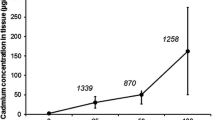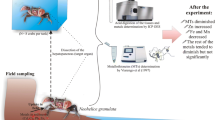Abstract
Subcellular distribution of mercury, selenium, silver, copper, zinc, and cadmium was determined in the liver of northern fur seals (Callorhinus ursinus), black-footed albatrosses (Diomedea nigripes), and Dall’s porpoises (Phocoenoides dalli). Mercury, selenium, and silver were preferentially accumulated in nuclear, lysosomal, and mitochondrial fraction with an increase in their hepatic concentrations, whereas copper, zinc, and cadmium were accumulated mainly in cytosol with an increase in the hepatic concentrations for all three species. To gain insight into the existing state of the metals, they were extracted with four extractants—sodium dodecylsulfate (SDS); 2-mercaptoethanol; 2-mercaptoethanol + guanidinium thiocyanate; and copper sulfate (CuSO4)—at several concentrations from nuclear, lysosomal, and mitochondrial fraction in liver from a specimen of northern fur seal. Extraction efficiencies of the metals for 2-mercaptoethanol + guanidinium thiocyanate and CuSO4 were much higher than those for SDS and 2-mercaptoethanol. Also, for all individuals of the three species, metals were extracted by the three extractants—2% SDS; 0.25 mol/L 2-mercaptoethanol + 5 mol/L guanidinium thiocyanate; and 0.1 mol/L CuSO4—from nuclear, lysosomal, and mitochondrial fraction of liver. In the northern fur seals with higher concentration of mercury, the molar ratio of selenium to mercury approached unity in the nonextractable fraction of 0.25 mol/L 2-mercaptoethanol + 5 mol/L guanidinium thiocyanate, suggesting the possible formation of mercuric selenide (HgSe) with increasing hepatic concentration. Because the nonextractable content of mercury and its distribution were larger for black-footed albatross than those for the other two species, it was suggested that the black-footed albatross has a stronger ability to form a stable compound(s) of mercury in the liver. It is notable that the existing state of silver was similar to that of mercury as judged by their subcellular distribution and the extraction tests, suggesting that silver also interacted with selenium in the liver of marine animals used in this study.
Similar content being viewed by others
Author information
Authors and Affiliations
Rights and permissions
About this article
Cite this article
Ikemoto, ., Kunito, ., Tanaka, . et al. Detoxification Mechanism of Heavy Metals in Marine Mammals and Seabirds: Interaction of Selenium with Mercury, Silver, Copper, Zinc, and Cadmium in Liver. Arch Environ Contam Toxicol 47, 402–413 (2004). https://doi.org/10.1007/s00244-004-3188-9
Issue Date:
DOI: https://doi.org/10.1007/s00244-004-3188-9




